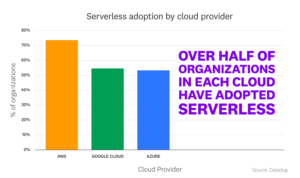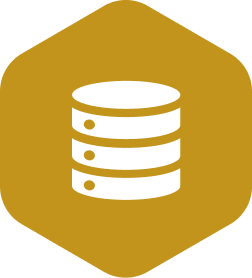Serverless has transformed application development by eliminating the need to provision and manage any underlying infrastructure. The current serverless ecosystem has grown more mature and has considerable overlap with the world of container-based technologies. The wide range of available options has led over half of the organizations operating in each cloud to adopt serverless.

As the popularity of FaaS products like AWS Lambda continues to grow, we have also seen a significant increase in adoption of other types of serverless technologies offered by Azure, Google Cloud, and AWS. This evolution highlights the growing range of options available to organizations who want to go serverless, as well as a shift in how serverless technologies are leveraged. For instance, in addition to using individual serverless functions to run event-driven code, many organizations are also deploying containerized applications on serverless platforms such as Azure Container Instances, Google Cloud Run, and Amazon ECS Fargate.
Experts predict serverless to be the operational model of the future. This architecture offers a range of benefits along with drawbacks as well, which we will explore in more detail later in this report.
1. What is Serverless architecture?
People who hear ‘Serverless’ for the first time normally have below reactions in my experience:
- Where does the code run?
- Who coined the term ‘Serverless’? There is no such thing, and it just confuses others.
- I like my servers, and it gives me control.
- Wait!! Back to my original question, where does the code run?
Indeed, all statements are valid. But the phrase ‘Serverless’ doesn’t mean servers are no longer involved. It simply means that developers no longer have to think much about them (i.e., going serverless lets developers shift their focus from server to task level).
That said, serverless architecture can be stated as follows:
Serverless architecture is an event-driven application design where multi-tier applications are constructed with the below specifications:
- Client components are preferable Single page applications
- Backend components depend on third-party service where,
- Application’s generic code like authentication, push notifications, data persistence, publish-subscribe messages, email delivery, geolocation data, files, media, streams, etc. is run from Backend as a Service (BaaS / MBaaS) providers and/or
- Application’s business-specific code runs in short-lived Function as a Service (FaaS) containers.
Too hard to remember? Well, let me try to construct a simple definition that is concise and straightforward. It goes as follows,
Serverless architecture is an event-driven design with multi-tier applications that depend on third-party services for backend where generic code is run in Backend as a Service (BaaS/MBaaS) providers and/or business-specific code runs in short-lived Function as a Service (FaaS) containers.
In Short, Serverless Architecture = Backend as a Service (BaaS) + Functions as a Service (FaaS)
The phrase ‘serverless’ doesn’t mean servers are no longer involved. It simply means that developers no longer have to think much about servers (i.e., going serverless lets developers shift their focus from server level to task level). Now that we know what serverless is, let’s go and explore a bit more on what constitutes a serverless architecture, i.e., BaaS and FaaS.
Backend as a Service:
Backend as a Service (BaaS) can be defined as a cloud service model that provides ways to connect web and mobile applications to common services like authentication, push or event-driven notifications, data storage, and user/file management via application programming interfaces (API) and software development kits (SDK).
Some BaaS features are similar to those of other service models like SaaS, IaaS, and PaaS, but BaaS is unique in explicitly addressing the needs of web and mobile applications. Providing a constant way to manage backend data means that developers don’t have to develop another backend for each service that the applications interface with.
A Backend as a Service consumed by a mobile application is referred to as Mobile Backend as a Service (MBaaS).
Functions as a Service:
Functions as a Service (FaaS) can be defined as a cloud service model where business-specific code (also termed as function) is executed in containers by FaaS platforms, and these containers are formed in response to events.
This means that FaaS users are able to conduct their programming (and other event-driven tasks) without hassle of managing their server(s). Code or Functions in the FaaS environment are triggered by events like an HTTP call to API gateway or a data packet in a data stream, whichever events the serverless platform supports. FaaS platform providers maintain the environment and containers in which functions are targeted to be executed and enable auto-scaling based on resource needs.
2. Advantages of Serverless architecture
Now we all know, Serverless architecture means breaking apart server-side applications into BaaS and/or FaaS functions that each performs a distinct task. A FaaS platform takes these functions and runs them in parallel “containers” that can be monitored and scaled separately. This new architecture delivers some key benefits, which are highlighted below:
Decreased time to market
Serverless approach allow developers to create new applications in hours and days instead of weeks and months. Examples abound in new apps that rely on third-party APIs for services like authentication (OAuth), social (Twitter), maps (Mapbox), artificial intelligence (IBM’s Watson), and more.
Enhanced scalability
One of the joys of serverless FaaS is, ‘horizontal scaling is completely automatic, elastic, and managed by the provider’. There are several benefits to this, but on the basic infrastructural side, the most significant advantage is that you only pay for the compute that you need, down to a 100ms boundary in the case of AWS Lambda. Depending on your traffic scale and shape, this may be a substantial economic win.
Lower cost
In terms of both computing power and human resources, serverless saves. Why pay to reinvent the wheel for authorization, presence detection, and image processing? Or to manage infrastructure? And if there’s no need for always-on servers, operational costs plummet. The days of spending hundreds of thousands of dollars for servers are gone.
More time for user experience
Users don’t care about infrastructure; they care about features and their experience. Serverless architecture allows teams to focus resources on the elements that keep users happy.
Improved latency and geolocation
An application’s ability to scale depends on its number of users, locations, and network latency. Current get applications have global audiences, creating latencies that diminish experiences. With serverless, providers have points of presence near every user, and apps perform equally well for everyone.
3. Drawbacks of Serverless architecture
Every good has bad in it, and so is with serverless architecture. While serverless provides benefits, it also poses critical challenges to enterprises. Here are some of the drawbacks of going serverless:
Problems due to third-party API system
Vendor control, multitenancy problems, vendor lock-in, and security concerns are some of the issues due to using 3rd party APIs. Giving up system control while implementing APIs can lead to system downtime, forced API upgrades, loss of functionality, unexpected limits, and cost changes.
Lack of operational tools
The developers are dependent on vendors for debugging and monitoring tools. Debugging Distributed Systems is complicated and usually requires access to a significant amount of relevant metrics to identify the root cause.
Architectural complexity
Decisions about how small (granular) the function should be, takes time to assess, implement and test. There should be a balance between the number of functions should an application call. It gets cumbersome to manage too many functions and ignoring granularity will end up creating mini-monoliths. AWS Lambda, for now, limits you to how many concurrent executions you can be running of all your lambdas. The problem here is that this limit is across your whole AWS account. Some organizations use the same AWS account for both production and testing. That means if someone, somewhere, in your organization does a new type of load test and starts trying to execute 1000 concurrent Lambda functions you’ll accidentally Denial of service (DoS) your production applications.
Implementation drawbacks
Integration testing Serverless applications is challenging. The units of integration with Serverless FaaS (i.e., each function) are much smaller than with other architectures; therefore, we rely on integration testing a lot more than we may do with different architectural styles. Problems related to deployment, versioning, and packaging also exist. You may need to deploy a FaaS artifact separately for every function in your entire logical application. It also means you can’t atomically deploy a group of functions, and there’s no concept of versioned applications, so atomic rollback isn’t an option. You may need to turn off whatever event source triggers the functions, deploy the whole group, and then turn the event source back on.
4. Serverless Architecture Use Cases
Today, you would find that the majority of new startups leverage the benefits of serverless architecture as they seek painless scaling and lower entry barriers in the market. Here, we have curated some of the use cases for serverless architecture models. Know which kind of applications you can build with this infrastructure.
Chatbots & Virtual Assistants
Messaging bots and AI assistants are the ideal choices that fit the serverless criteria. Since people utilizing chat apps look for an instant response, serverless data aids in doing that. As your users increase from one hundred to thousands, your processing time should stay the same, which is automated with the Function as a service.
Internet of Things (IoT) Applications
The real-time response of the Serverless infrastructure makes it suitable for developing IoT applications. IoT apps require constant monitoring over quantities like weather, pulse rate, temperature, etc. So, this serverless architecture helps you keep up with the changes tracked of quantities on a real-time basis.
It ensures that your purchased service doesn’t sit idle and works 24/7 to make your IoT app seamless.
Heavy Image Oriented Applications
Every application heavily relies on the user experience to succeed in the competitive market. Especially rich image-oriented apps should have a unique user experience for every user.
Today, we know that every device has different dimensions. To provide a perfect view of every image, developers must provide multiple versions of the same image for the various screen sizes- from mobile, desktops, to laptops. But, platforms like Google and AWS lambda automatically optimize images for every need, making it a perfect solution for image-heavy apps.
Agile & Rapid Development Process
If you are looking for an agile and rapid development process, serverless could be a suitable choice. An agile or rapid integration process requires the execution of a particular code when needed, which goes in line with serverless technology. Since you separate your codebase into functions in this infrastructure, bug fining becomes easy.
Conclusion
As described above, serverless architecture patterns come with a number of values, not least of all the ability to customize and scale, providing a function-as-a-service. But what you don’t get when you utilize serverless computing for your application architecture is control.
It remains to be seen, what the future does serverless holds for app development. Are you a startup or a business looking for a reliable partner to help you choose the right cloud platform for your web app? As a leading application development platform, we have helped many enterprises to adopt the cloud-first approach and achieve their business objectives. Let’s talk.
Ready to take the next step?
Sunteco Cloud provides technology solutions and products through the Sunteco Cloud ecosystem, accelerating the digital transformation journey of businesses of all sizes. We focus on creating simple, engaging, and scalable solutions to ensure that we understand your business and challenges to deliver significant results effectively. Each product is just a piece of the big business picture. So we don’t start from our product but your business.
> Learn more Sunteco Cloud ecosystem
> See more Sunteco Cloud products’ pricing plan
> Start a free trial with Sunteco Cloud products and get $100 when creating a new account (contact us for promotion code)




